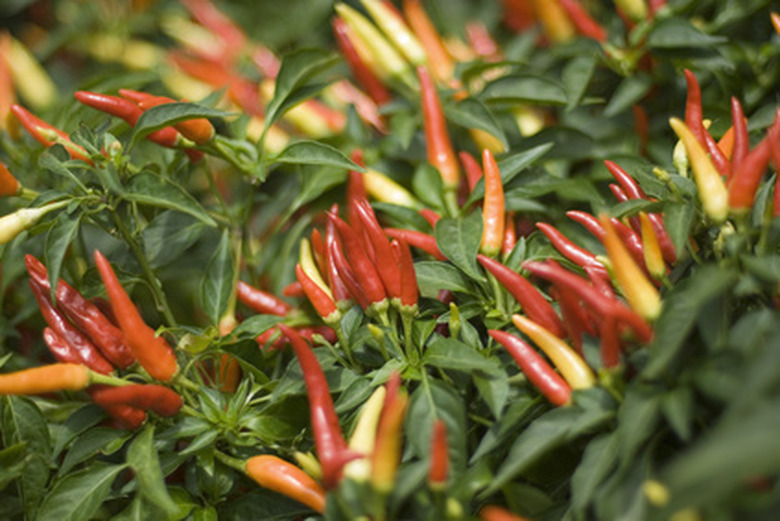How To Care For A Thai Pepper Plant
Thai hot pepper plants are dual-duty plants, both edible and ornamental. Like all pepper plants, Thai hot pepper plants will thrive in warm weather and plenty of sunshine. The interesting shape and bright colors of the plants make Thai pepper right at home along a border, in a flower bed, or planted in a patio container. The peppers start out as a lovely green color, soon ripening to bright red. Once the plants are established, very little care is required.
Step 1
Plant Thai pepper plants outdoors two to three weeks after the last expected frost of the season, when the nighttime temperatures have reached 60 degrees Fahrenheit. Thai peppers require well-drained soil, full sunlight and protection from hot, dry wind. To grow Thai peppers in containers, choose a container with a drainage hole, and fill the container with all-purpose commercial potting soil.
- Thai hot pepper plants are dual-duty plants, both edible and ornamental.
- Plant Thai pepper plants outdoors two to three weeks after the last expected frost of the season, when the nighttime temperatures have reached 60 degrees Fahrenheit.
Step 2
Fertilize Thai pepper plants immediately after planting, using an all-purpose granular fertilizer. Apply fertilizer again when small peppers begin to form. Containerized Thai pepper plants should be fed an all-purpose balanced liquid fertilizer.
Step 3
Keep the soil most at all times, and never allow the soil to become bone dry as excessively dry soil will cause the plant to drop blossoms. It's especially important to water Thai hot peppers during hot, dry weather. Containerized plants may need to be watered twice daily, as the soil in containers dries out quickly.
Care For A Thai Pepper Plant
Test the pH of the soil in the Thai pepper plant pot. You can buy test kits at garden centers and home improvement stores. Apply a 5-10-5 fertilizer to the soil. Thai pepper plants grown in containers require a great deal of moisture.
- Fertilize Thai pepper plants immediately after planting, using an all-purpose granular fertilizer.
- Containerized Thai pepper plants should be fed an all-purpose balanced liquid fertilizer.
Things Needed
- Thai pepper plant
- Container with drainage hole
- All-purpose commercial potting soil
- All-purpose balanced or liquid fertilizer
Warning
If you smoke, be sure to wash your hands before handling Thai hot pepper plants, as tobacco mosaic disease can be passed on to the plants. Be careful where you plant Thai hot pepper. Keep containerized plants out of reach of curious children and pets.
References
- University of Illinois: http://urbanext.Illinois.edu/veggies/peppers1.html
- Cornell University: Vegetable Growing Guide: Pepper
- University of Florida Suwannee County Extension Office: Most Used Hot Pepper Varieties
- University of Illinois Extension: Watch Your Garden Grow: Peppers
- University of Arkansas Division of Agriculture: Home Gardening Series: Peppers
